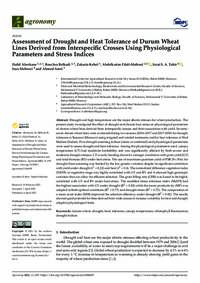Assessment of Drought and Heat Tolerance of Durum Wheat Lines Derived from Interspecific Crosses Using Physiological Parameters and Stress Indices

Authors:
Drought and high temperature are the major abiotic stresses for wheat production. The present study investigated the effect of drought and chronic heat stress on physiological parameters of durum wheat lines derived from interspecific crosses and their association with yield. Seventy-seven durum wheat lines were evaluated during two seasons (2016-2017 and 2017-2018) for drought tolerance at Tessaout (Morocco) using irrigated and rainfed treatments and for heat tolerance at Wad Medani (Sudan). Five drought screening indices (alone or combined) and physiological parameters were used to assess drought and heat tolerance. Among the physiological parameters used, canopy temperature (CT) had moderate heritability and was significantly affected by both severe and moderate drought stresses. CT at early heading showed a stronger correlation with grain yield (GY) and total biomass (BY) under heat stress. The use of maximum quantum yield of PSII (Fv/Fm) for drought/heat screening was limited by the low genetic variation despite its significant correlation with yield under drought (r(2) = 0.22) and heat (r(2) = 0.4). The normalized difference vegetation index (NDVI) at vegetative stage was highly correlated with GY and BY and it showed high genotypic variation that can allow for efficient selection. The grain filling rate (GFR) was found to be highly correlated with GY and BY under heat stress. The modified stress tolerance index (MsSTI) had the highest association with GY under drought (R-2 = 0.82) while the mean productivity (MP) was adapted to both optimal conditions (R-2 = 0.77) and drought stress (R-2 = 0.73). The computation of a mean score index (MSI) improved the selection efficiency under drought (R-2 = 0.92). The results showed good potential for lines derived from wide crosses to increase variability for heat and drought adaptive physiological traits.
